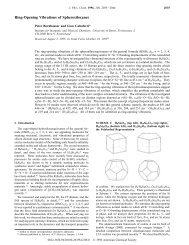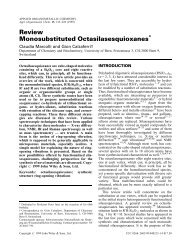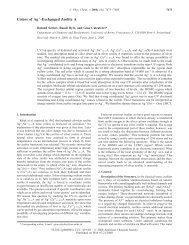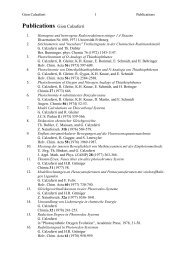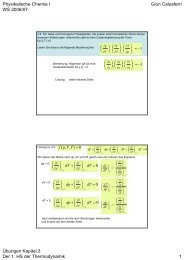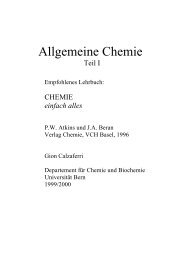Photonic antenna system for light harvesting
Photonic antenna system for light harvesting
Photonic antenna system for light harvesting
You also want an ePaper? Increase the reach of your titles
YUMPU automatically turns print PDFs into web optimized ePapers that Google loves.
Fig. 2 a) Side and top views of zeolite L crystals with a length of<br />
950 nm and a diameter of 850 nm, respectively. b) A schematic view of<br />
some channels in a hexagonal zeolite crystal with cylindrical morphology.<br />
This is a pre-publication version of figures to be included in a<br />
<strong>for</strong>thcoming work tentatively titled Advances in Photochemistry<br />
Volume 27 edited by D.C. Neckers, to be published in 2002. Copyright<br />
# 2001 John Wiley & Sons Inc. All rights reserved.<br />
as illustrated in Fig. 1b). The material was investigated by<br />
stationary energy migration experiments on an ensemble and<br />
space and time resolved measurements on single crystals. 6<br />
The general synthesis concept of this inorganic–organic<br />
composites is based on the specific geometrical constraints<br />
imposed by the parallel arrangement of one-dimensional<br />
channels of the host. 4,5 Various synthesis strategies <strong>for</strong> the<br />
preparation of chromophores in porous silica and minerals<br />
have been reviewed recently. 7 Zeolite L crystals usually have<br />
cylindrical morphology, as illustrated in Fig. 2, where we also<br />
show a schematic view of their channel structure. The number<br />
of parallel channels which coincide with the c-axis of the hexagonal<br />
framework is equal to 1.07rcyl 2 , where rcyl is the radius of<br />
the crystal in nm. The length of a unit cell along the c-axis is<br />
0.75 nm. This means that a crystal of e.g. 600 nm diameter and<br />
300 nm length gives rise to about 100000 parallel channels, each<br />
consisting of 400 unit cells (u.c.). 8–11<br />
Control of the shape and size of the crystals is a necessary<br />
prerequisite <strong>for</strong> particular applications. Large crystals of a few<br />
hundred to a few thousand nm are very useful <strong>for</strong> studying the<br />
optical and photophysical properties of dye–zeolite composites<br />
on single crystals by means of optical microscopy methods.<br />
Crystals in the range of a few tenths to a few hundred nm are<br />
needed <strong>for</strong> high efficiency photonic <strong>antenna</strong> materials, useful as<br />
fluorescent microprobes in cell biology and analytical chemistry,<br />
12 <strong>for</strong> developing a new generation of dye sensitised solid<br />
state solar cells, 13 or <strong>for</strong> preparing a new generation of <strong>light</strong><br />
emitting diodes. We have recently shown how fine tuning of the<br />
size of zeolite L crystals in the size range of 30 nm up to<br />
3000 nm can be realised by changing the composition of the<br />
starting gel <strong>for</strong> otherwise constant reaction conditions. It was<br />
thus possible to extend the investigations on energy migration<br />
in Py z -loaded zeolite L crystals, modified with Ox z as a<br />
luminescent acceptor at the ends of the crystals; see Table 1 <strong>for</strong><br />
the structuresd of these molecules. 1,5<br />
Some dye molecules which have been inserted into zeolite L<br />
are given in Table 1 where we also give abbreviations used in<br />
this article. It is important to distinguish between three types of<br />
dye molecules. (i) Molecules small enough to fit into a single unit<br />
cell. Some examples are biphenyl (BP), hydoxy-TEMPO,<br />
fluorenone, and naphthalene. (ii) Molecules the size of which<br />
makes it hard to guess if they align along the c-axis or if they find<br />
a way to fit into a single unit cell. Ox z ,Py z , and Th z are<br />
molecules of this type. 15 (iii) Molecules which are so large that<br />
they have no other choice but to align along the c-axis. Many<br />
2 J. Mater. Chem., 2002, 12, 1–13<br />
examples fit into this category. POPOP, DMPOPOP, MBOXE,<br />
pTP, and DPH are among these. It is important to know more<br />
precisely which of the type (ii) and (iii) molecules can arrange in<br />
a way so that they can interact via their p-<strong>system</strong>s and which<br />
are only in physical contact, i.e. have negligible electronic<br />
interaction.<br />
2. Energy migration<br />
The two cationic dyes Py z , as a donor, and Ox z , as an<br />
acceptor, were found to be very versatile to demonstrate<br />
photonic <strong>antenna</strong> functionalities <strong>for</strong> <strong>light</strong> <strong>harvesting</strong>, transport,<br />
and capturing, as illustrated in Fig. 3. They can be incorporated<br />
into zeolite L by means of ion exchange, where they are<br />
present as monomers because of the restricted space. In this<br />
<strong>for</strong>m they have a high fluorescence quantum yield and<br />
favourable spectral properties. The insertion of the dyes can<br />
be visualised by means of fluorescence microscopy. The<br />
fluorescence anisotropy of Ox z -loaded zeolite L has recently<br />
been investigated in detail by conventional and by confocal<br />
microscopy techniques. 15<br />
The occupational probability p of the sites with a dye is equal<br />
to the number of occupied sites divided by the number of sites<br />
available. Using this notion the Förster type energy transfer<br />
16,17 and the energy migration rate constant k ij from a<br />
molecule i to a molecule j in this material can be expressed by: 2<br />
9( ln 10)<br />
128p5NAn4 Wi<br />
kij~ GijJijpipj<br />
(1)<br />
ti<br />
where Wi and ti [s 21 ] are the fluorescence quantum yield and the<br />
intrinsic fluorescence lifetime of the donor, NA is the Avogadro<br />
number, n is the refractive index of the medium, Gij [A˚ 26 ]<br />
represents the geometrical constraints of the sites in the crystal<br />
and the relative orientation of the electronic transition moments,<br />
pi and pj are the occupational probabilities of the sites with<br />
excited donors i and acceptors j in the ground state, and Jij<br />
[cm 3 M 21 ] is the spectral overlap integral between the normalised<br />
donor emission and the acceptor absorption spectrum.<br />
We describe properties of Py z -loaded zeolite L of which the<br />
channel ends are modified with Ox z .Ox z acts as an acceptor<br />
which becomes excited via radiationless energy transfer from an<br />
excited Py z moiety. If radiationless relaxation is not considered,<br />
Ox z can lose its excitation energy only by luminescence,<br />
as it cannot transfer the energy back to Py z because of<br />
its lower value. Fluorescence of excited Py z , internal conversion,<br />
and inter<strong>system</strong> crossing compete with the energy migration<br />
and energy transfer processes. The efficiency of energy<br />
migration among the Py z molecules along the crystal can be<br />
investigated by measuring the front–back trapping efficiency<br />
TFB,‘. The front–back trapping efficiency is equal to the ratio<br />
of fluorescence intensity emitted by the acceptor Ox z (IA) divided by the total fluorescence intensity (IAzID). 2,18<br />
TFB,?~ IA<br />
IDzIA<br />
Two important parameters we can vary independently in order<br />
to test the energy migration efficiency are the loading with<br />
donor molecules Py z , which we express as ppy, and the length<br />
lcyl of the crystals. The front–back trapping efficiency TFB,‘ can<br />
be tested by exciting the crystals at a wavelength where the<br />
acceptor absorption is negligible. We expect that TFB,‘<br />
decreases with increasing crystal length lcyl <strong>for</strong> otherwise<br />
constant parameters, specifically constant ppy, because the<br />
excitation energy has to migrate over an increasingly large<br />
distance to reach an acceptor. This can be tested by using<br />
materials with different average crystal lengths.<br />
We show in Fig. 4 experimental results obtained with crystals<br />
of the following average lengths: A, 300 nm; B, 500 nm; C,<br />
850 nm; D, 1400 nm; and E, 2400 nm. These crystals were<br />
(2)




